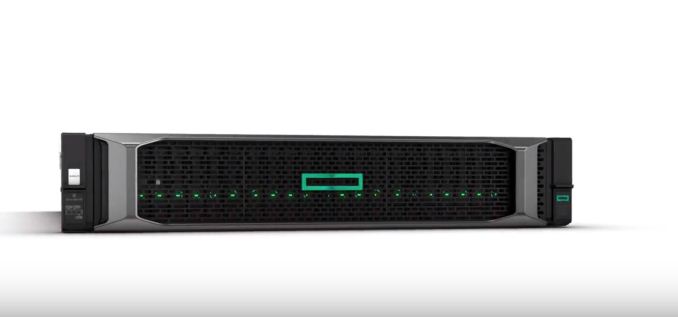HPE Unveils ProLiant DL385 Gen10: Dual Socket AMD EPYC
by Dr. Ian Cutress on November 14, 2017 10:00 AM EST
In a video on YouTube, which has since been hastily removed, Hewlett Packard Enterprise (HPE) opened the can a little early on announcing a new dual socket AMD EPYC based system in a 2U form factor. As pointed out over at ServeTheHome, this is an important metric in the EPYC story: it is one of the first machines from a top 3 server equipment manufacturer.
Before the video was removed, it showed a dual-socket design with a full set of memory slots (that’s 32x, supporting a total of 4TB). Leveraging the 128 PCIe lanes that the configuration would bring, the DL385 Gen10 showed support for up to 24 NVMe drives (or 30 2.5” SATA SSDs) as well as either three double-wide GPUs or five single-slot GPUs. The aim for such a server seems to be a crossover between storage and compute, or the ability to maintain constant compute throughput with plenty of memory and fast local storage, such as large datasets for AI or deep learning network training. Redundant power supplies and HPE iLO management are also featured.
In AMD’s press release for this week’s Supercomputing 17 event, HPE was listed as one of the vendors now ready to start offering the availability of EPYC-based systems, now that the major cloud and hosting providers are getting to grips with the technology. HPE VP and GM, Justin Hotard, was quoted in AMD’s press release, saying that ‘AMD delivers the power … to help break barriers’, but no official or specific products were mentioned in the quote given to AMD. Along those lines, we would expect HPE to have its own announcement, probably this week as it is SuperComputing, although posting/deposting a video says a lot.
We suspect that when HPE pull the proper trigger on the launch, the video will be re-enabled and data sheets will start flowing. We will report when it happens, but here’s the video embed in case it comes online soon.
Update 11/20
The HPE ProLiant DL385 Gen10 website is now live, with the focus on lowering the TCO per Virtual Machine. Shipping starts in December.
The HPE ProLiant DL385 delivers unmatched security via the HPE Silicon Root of Trust, a unique link between the HPE Integrated Light Out (iLO) silicon and the iLO firmware to ensure servers do not execute compromised firmware code. The HPE Silicon Root of Trust is connected to the AMD Secure Processor in the AMD EPYC™ SoC so that the AMD Secure Processor can validate the HPE firmware before the server is allowed to boot.
https://www.hpe.com/us/en/servers/proliant-dl-servers.html
Related Reading
Source: ServeTheHome











20 Comments
View All Comments
PeachNCream - Tuesday, November 14, 2017 - link
The reason why the broken video link is still there is stated in the text right above it. Ian's leaving it there in the event that HPE puts it back online after they make their upcoming product annoucement.MrCommunistGen - Tuesday, November 14, 2017 - link
Facepalm. Thanks. I guess I didn't finish reading the article.PeachNCream - Tuesday, November 14, 2017 - link
No problem! It's kinda missable when you're reading. My eyes were drawn to the video right away and I missed the thing explaining why too. It took a second look before it made sense.IGTrading - Tuesday, November 14, 2017 - link
We have a new floor mop for the holidays : Intel Xeon. :)I'm being a bit mean, but Intel needs to upgrade its lineup because their whole server line doesn't make any financial sense in front of AMD EPYC.
p1esk - Tuesday, November 14, 2017 - link
128 PCIe lanes and only 3 double wide PCIe slots?MrCommunistGen - Tuesday, November 14, 2017 - link
I don't think there's room in the chassis for much more. I think the focus on this model is more around NVMe storage as opposed to throwing as many compute cards in it as possible.Alex_Haddock - Thursday, November 16, 2017 - link
Ok, so as I work for HPE I'm not commenting on a DL385 of course :-) ; but I would point out that the DL38x range uses a riser system so that additional risers can be added depending on the I/O needed (or be left out to reduce some cost for those who don't need them). If you look at the Intel DL380Gen10 it ships with a 3 slot primary riser but can have additional secondary and tertiary risers. Its possible that a hypothetical 2P Epyc system might have a slight advantage in lanes here.Cheers, Alex
msroadkill612 - Wednesday, November 15, 2017 - link
All the epyc mobos seem to offer too little space/slots to have a hope of using 128 lanes.One I saw had a 40 lane and also a 32 lane riser slot, which i imagine is a fix.
Serverental - Tuesday, April 10, 2018 - link
Excellent information about the low cost virtual machine HPE Proliant DL385 G10 server.Rοb - Wednesday, April 25, 2018 - link
The Gen10 video is here: https://www.youtube.com/watch?v=gx-Cppzj2Ts